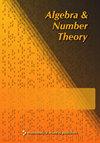Affine Deligne–Lusztig varieties via the double Bruhat graph, II : Iwahori–Hecke algebra
IF 1
1区 数学
Q2 MATHEMATICS
引用次数: 0
Abstract
We introduce a new language to describe the geometry of affine Deligne–Lusztig varieties in affine flag varieties. This second part of a two-paper series uses this new language, i.e., the double Bruhat graph, to describe certain structure constants of the Iwahori–Hecke algebra. As an application, we describe nonemptiness and dimension of affine Deligne–Lusztig varieties for most elements of the affine Weyl group and arbitrary -conjugacy classes.
通过重Bruhat图的仿射delign - lusztig变分,II: Iwahori-Hecke代数
我们引入了一种新的语言来描述仿射标志变体中的仿射delign - lusztig变体的几何形状。本文的第二部分使用这种新的语言,即双Bruhat图,来描述Iwahori-Hecke代数的某些结构常数。作为应用,我们描述了仿射Weyl群和任意σ-共轭类的大多数元素的仿射delign - lusztig变的非空性和维数。
本文章由计算机程序翻译,如有差异,请以英文原文为准。
求助全文
约1分钟内获得全文
求助全文
来源期刊

Algebra & Number Theory
MATHEMATICS-
CiteScore
1.80
自引率
7.70%
发文量
52
审稿时长
6-12 weeks
期刊介绍:
ANT’s inclusive definition of algebra and number theory allows it to print research covering a wide range of subtopics, including algebraic and arithmetic geometry. ANT publishes high-quality articles of interest to a broad readership, at a level surpassing all but the top four or five mathematics journals. It exists in both print and electronic forms.
The policies of ANT are set by the editorial board — a group of working mathematicians — rather than by a profit-oriented company, so they will remain friendly to mathematicians'' interests. In particular, they will promote broad dissemination, easy electronic access, and permissive use of content to the greatest extent compatible with survival of the journal. All electronic content becomes free and open access 5 years after publication.
 求助内容:
求助内容: 应助结果提醒方式:
应助结果提醒方式:


